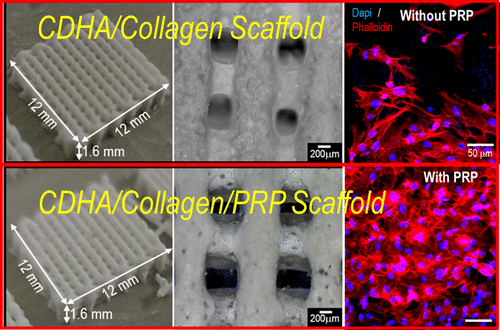当前位置:
X-MOL 学术
›
ACS Biomater. Sci. Eng.
›
论文详情
Our official English website, www.x-mol.net, welcomes your
feedback! (Note: you will need to create a separate account there.)
Calcium-Deficient Hydroxyapatite/Collagen/Platelet-Rich Plasma Scaffold with Controlled Release Function for Hard Tissue Regeneration
ACS Biomaterials Science & Engineering ( IF 5.4 ) Pub Date : 2017-12-15 00:00:00 , DOI: 10.1021/acsbiomaterials.7b00640 JiUn Lee 1 , GeunHyung Kim 1
ACS Biomaterials Science & Engineering ( IF 5.4 ) Pub Date : 2017-12-15 00:00:00 , DOI: 10.1021/acsbiomaterials.7b00640 JiUn Lee 1 , GeunHyung Kim 1
Affiliation

|
Calcium phosphate cement scaffolds have been extensively used in bone tissue regeneration applications because they are similar to the inorganic components of bones and have outstanding biocompatibility. However, the main shortcomings of ceramic scaffolds are their brittleness and low retention level of various growth factors or drugs. To overcome these shortcomings, we have reinforced ceramic scaffolds using synthetic and natural polymers as composites. Here, we designed a new bone-biomimetic composite consisting of calcium deficient hydroxyapatite (CDHA), collagen, and plate-rich plasma (PRP) using low temperature printing process. In the biocomposite, we manipulated the release of the bioactive component, PRP, which has several growth factors, for a long culture period (up to 35 days) by using a polyphenol, tannic acid. The mesh-structured biocomposite showed structural stability. We also tested the in vitro biocompatibilities of the biocomposite using preosteoblasts (MC3T3-E1) and found that the biocomposite showed better cell growth and differentiation compared to the control (fabricated without PRP). Although effects of platelet-rich plasma have remained controversial, our results indicated controlled release of PRP with a biocomposite showed enhanced proliferation and differentiation of preosteoblast cells.
中文翻译:

具有控释功能的缺钙羟基磷灰石/胶原蛋白/富含血小板的血浆支架,可用于硬组织再生
磷酸钙水泥支架被广泛用于骨骼组织再生应用,因为它们与骨骼的无机成分相似并且具有出色的生物相容性。然而,陶瓷支架的主要缺点是它们的脆性和各种生长因子或药物的低保留水平。为了克服这些缺点,我们使用合成和天然聚合物作为复合材料来增强陶瓷支架。在这里,我们设计了一种新型的仿骨复合材料,该组合物采用低温印刷工艺,由缺钙的羟基磷灰石(CDHA),胶原蛋白和富含板的血浆(PRP)组成。在生物复合材料中,我们通过使用多酚鞣酸在较长的培养期间(长达35天)中操纵了具有多种生长因子的生物活性成分PRP的释放。网状结构的生物复合材料显示出结构稳定性。我们还使用前成骨细胞(MC3T3-E1)测试了生物复合材料的体外生物相容性,发现与对照(无PRP的情况)相比,该生物复合材料显示出更好的细胞生长和分化能力。尽管富血小板血浆的作用仍存在争议,但我们的研究结果表明,使用生物复合材料控制PRP的释放显示了成骨前细胞的增殖和分化增强。
更新日期:2017-12-15
中文翻译:

具有控释功能的缺钙羟基磷灰石/胶原蛋白/富含血小板的血浆支架,可用于硬组织再生
磷酸钙水泥支架被广泛用于骨骼组织再生应用,因为它们与骨骼的无机成分相似并且具有出色的生物相容性。然而,陶瓷支架的主要缺点是它们的脆性和各种生长因子或药物的低保留水平。为了克服这些缺点,我们使用合成和天然聚合物作为复合材料来增强陶瓷支架。在这里,我们设计了一种新型的仿骨复合材料,该组合物采用低温印刷工艺,由缺钙的羟基磷灰石(CDHA),胶原蛋白和富含板的血浆(PRP)组成。在生物复合材料中,我们通过使用多酚鞣酸在较长的培养期间(长达35天)中操纵了具有多种生长因子的生物活性成分PRP的释放。网状结构的生物复合材料显示出结构稳定性。我们还使用前成骨细胞(MC3T3-E1)测试了生物复合材料的体外生物相容性,发现与对照(无PRP的情况)相比,该生物复合材料显示出更好的细胞生长和分化能力。尽管富血小板血浆的作用仍存在争议,但我们的研究结果表明,使用生物复合材料控制PRP的释放显示了成骨前细胞的增殖和分化增强。











































 京公网安备 11010802027423号
京公网安备 11010802027423号